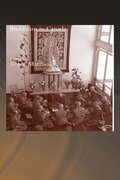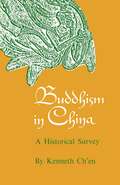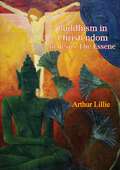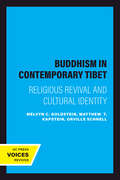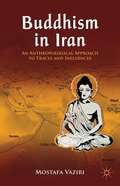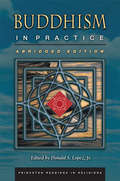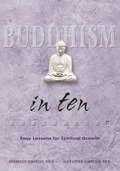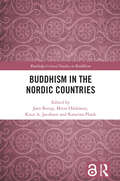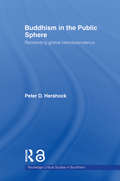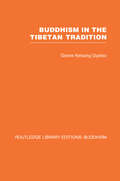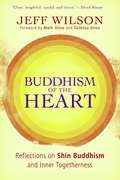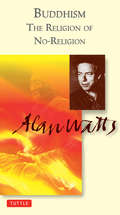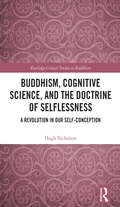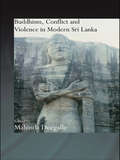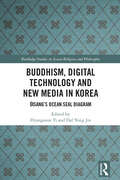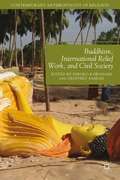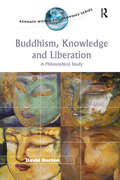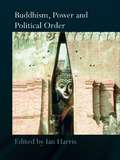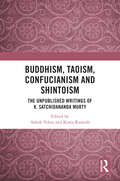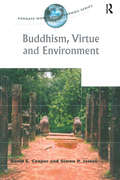- Table View
- List View
Buddhism in Canada (Routledge Critical Studies in Buddhism)
by Bruce MatthewsBuddhism has become a major religion in Canada over the last half-century. The 'ethnic Buddhism' associated with immigrant Asian people is the most important aspect, but there is also a growing constituency of Euro-Canadian Buddhists seriously interested in the faith. This insightful study analyzes the phenomenon of Buddhism in Canada from a regional perspective. The work provides an important examination of the place of Buddhism in a developed western country associated with a traditional Judeo-Christian culture, but undergoing profound sociological transformation due to large-scale immigration and religio-cultural pluralism. It is a valuable text for students of religion, Buddhism and North American Studies.
Buddhism in China: A Historical Survey
by Kenneth Kuan Ch'enCONTENTS: Preface. Table of Chinese Dynasties. Maps of Dynasties. Introduction, Growth and Domestication. Maturity and Acceptance. Decline. Conclusion. Glossary. Chinese Names and Titles. Bibliography. Index.
Buddhism in Christendom or Jesus The Essene
by Arthur LillieA pivotal work studying the influences of Buddhism on Christianity.IT has been wisely said that, to understand any solitary religion, two, at least, must be studied. This seems essentially important when the religion is Eastern, and the student has been educated in the West. There is a tendency in the human mind to explain to itself that which is remote by that which is familiar. The Western mind is logical, matter-of-fact, impatient of symbolism. And yet Christianity is an Asiatic religion, and all Asiatics tell us that symbolism is the only language by which the facts of the spiritual world can be treated.
Buddhism in Contemporary Tibet: Religious Revival and Cultural Identity
by Melvyn C. Goldstein Mathew T. KapsteinFollowing the upheavals of the Cultural Revolution, the People's Republic of China gradually permitted the renewal of religious activity. Tibetans, whose traditional religious and cultural institutions had been decimated during the preceding two decades, took advantage of the decisions of 1978 to begin a Buddhist renewal that is one of the most extensive and dramatic examples of religious revitalization in contemporary China. The nature of that revival is the focus of this book. Four leading specialists in Tibetan anthropology and religion conducted case studies in the Tibet autonomous region and among the Tibetans of Sichuan and Qinghai provinces. There they observed the revival of the Buddhist heritage in monastic communities and among laypersons at popular pilgrimages and festivals. Demonstrating how that revival must contend with tensions between the Chinese state and aspirations for greater Tibetan autonomy, the authors discuss ways that Tibetan Buddhists are restructuring their religion through a complex process of social, political, and economic adaptation. Buddhism has long been the main source of Tibetans' pride in their culture and country. These essays reveal the vibrancy of that ancient religion in contemporary Tibet and also the problems that religion and Tibetan culture in general are facing in a radically altered world.
Buddhism in Iran
by Mostafa VaziriExploring the interactions of the Buddhist world with the dominant cultures of Iran in pre- and post-Islamic times, Vaziri demonstrates that the traces and cross-influences of Buddhism have brought the material and spiritual culture of Iran to its present state even after the term was eradicated from the literary and popular language of the region.
Buddhism in Practice
by Donald S. Lopez Jr.This anthology, first published in 1995, illustrates the vast scope of Buddhist practice in Asia, past and present. Re-released now in a slimmer but still extensive edition, Buddhism in Practice presents a selection of thirty-five translated texts--each preceded by a substantial introduction by its translator. These unusual sources provides the reader with a sense of the remarkable diversity of the practices of persons who over the course of 2,500 years have been identified, by themselves or by others, as Buddhists. Demonstrating the many continuities among the practices of Buddhist cultures widely separated by both history and geography, Buddhism in Practice continues to provide an ideal introduction to Buddhism and a source of new insights for scholars.
Buddhism in Ten
by Annellen Simpkins C. Alexander SimpkinsMore than any other introduction to Buddhism, Buddhism in Ten provides readers with the understanding and tools they need to live a deeper and fuller life along Buddhist principles. Ten lessons, each inspired by an aspect of Buddhism, show how to incorporate this Eastern philosophy into your daily life. Each lesson is enhanced with several exercises-some physical, some mental, and some spiritual.The lessons include:Understanding yourself through the Eight-fold PathPracticing mindfulness and meditationOvercoming cravingsIntegrating Buddhism into your workPracticing compassion and loving kindnessLiving a happy, enlightened lifeThe books in the Ten Easy Lessons series offer easy, practical, how-to programs that complement the primarily informational books in the Simpkins' Simple series.
Buddhism in Ten
by Annellen Simpkins C. Alexander SimpkinsMore than any other introduction to Buddhism, Buddhism in Ten provides readers with the understanding and tools they need to live a deeper and fuller life along Buddhist principles. Ten lessons, each inspired by an aspect of Buddhism, show how to incorporate this Eastern philosophy into your daily life. Each lesson is enhanced with several exercises-some physical, some mental, and some spiritual.The lessons include:Understanding yourself through the Eight-fold PathPracticing mindfulness and meditationOvercoming cravingsIntegrating Buddhism into your workPracticing compassion and loving kindnessLiving a happy, enlightened lifeThe books in the Ten Easy Lessons series offer easy, practical, how-to programs that complement the primarily informational books in the Simpkins' Simple series.
Buddhism in the Modern World (Religions in the Modern World)
by David L. McMahanBuddhism in the Modern World explores the challenges faced by Buddhism today, the distinctive forms that it has taken and the individuals and movements that have shaped it. Part One discusses the modern history of Buddhism in different geographical regions, from Southeast Asia to North America. Part Two examines key themes including globalization, gender issues, and the ways in which Buddhism has confronted modernity, science, popular culture and national politics. Each chapter is written by a distinguished scholar in the field and includes photographs, summaries, discussion points and suggestions for further reading. The book provides a lively and up-to-date overview that is indispensable for both students and scholars of Buddhism.
Buddhism in the Nordic Countries (Routledge Critical Studies in Buddhism)
by Knut A. Jacobsen Katarina Plank Jørn Borup Mitra HärkönenThis book provides new unprecedented research on Buddhism in the five Nordic countries Denmark, Finland, Iceland, Norway and Sweden. Aiming at comparisons between the different Nordic countries, the chapters identify possible unique characteristics of Nordic Buddhism.uddhism in the Nordic Countries contributes to the growing literature on Buddhism in the West. Identifying a number of similar cultural and social trends that have been at work in the Nordic countries, the book shows that these have favoured the growth of Buddhism in northern Europe. The chapters on each of the Nordic countries describe the establishment of the main Buddhist traditions in the country, temple institutions, monasteries, demography, estimation on the number of Buddhists, geography, economy and funding. They discuss tensions between ethnic Buddhist and converts, if any, and controlling mechanisms of who is a proper Buddhist and how Buddhism should be presented in public space. The contributors analyse representation in media and images of Buddhism in popular culture and present relevant scholarly interest in Buddhism. Additionally, the book includes chapters on significant Buddhist individuals in the Nordic countries who have played major roles in the development of Buddhism.The first book to examine the characteristics of Nordic Buddhism, its connection to the ideology of the Nordic welfare society and to establish if Nordic Buddhism might differ from other forms of Buddhism, this work will be of interest to researchers in the field of religious studies, religion in context and Buddhist studies.
Buddhism in the Public Sphere: Reorienting Global Interdependence (Routledge Critical Studies in Buddhism)
by Peter D. HershockThe core teachings and practices of Buddhism are systematically directed toward developing keen and caring insight into the relational or interdependent nature of all things. Hershock applies Buddhist thought to reflect on the challenges to public good, created by emerging social, economic, and political realities associated with increasingly complex global interdependence. In eight chapters, the key arenas for public policy are addressed: the environment, health, media, trade and development, the interplay of politics and religion, international relations, terror and security, and education. Each chapter explains how a specific issue area has come to be shaped by complex interdependence and offers specific insights into directing the growing interdependence toward greater equity, sustainability, and freedom. Thereby, a sustained meditation on the meaning and means of realizing public good is put forward, which results in a solid Buddhist conception of diversity. Hershock argues that concepts of Karma and emptiness are relevant across the full spectrum of policy domains and that Buddhist concepts become increasingly forceful as concerns shift from the local to the global. A remarkable book on this fascinating religion, Buddhism in the Public Sphere will be of interest to scholars and students in Buddhist studies and Asian religion in general.
Buddhism in the Tibetan Tradition: A Guide (Routledge Library Editions: Buddhism)
by Geshe Kelsang GyatsoA clear and straightforward introduction to Tibetan Buddhism, this book presents the basic teachings of Buddha in a way that people can readily comprehend and put into practice in their daily lives. Topics such as reincarnation, actions and their effects, emptiness, liberation and enlightenment are discussed. Designed primarily for those coming to the subject for the first time, the book also offers new insights for the more advanced student of Tibetan Buddhism. Originally published in 1989.
Buddhism of the Heart
by Taitetsu Unno Jeff Wilson Mark UnnoJeff Wilson started his walk on the Buddha's path as a Zen practitioner - taking up a tradition of vigorous self-effort, intensive meditation, and meticulous attention to rectitude in every action. But in Jeff's case, rather than freeing him from his suffering, he found those Zen practices made him nothing short of insufferable. And so he turned to Shin Buddhism - a path that is easily the most popular in Zen's native land of Japan but is largely unknown in the West. Shin emphasizes an "entrusting heart," a heart that is able to receive with gratitude every moment of our mistake-filled and busy lives. Moreover, through walking the Shin path, Jeff comes see that each of us (himself especially included) are truly "foolish beings," people so filled with endlessly arising "blind passions" and ingrained habits that we so easily cause harm even with our best intentions. And even so, Shin holds out the tantalizing possibility that, by truly entrusting our foolish selves to the compassionate universe, we can learn to see how this foolish life, just as it is, is nonetheless also a life of grace. Buddhism of the Heart is a wide-ranging book of essays and open-hearted stories, reflections that run the gamut from intensely personal to broadly philosophical, introducing the reader to a remarkable religious tradition of compassionate acceptance.
Buddhism the Religion of No-Religion
by Alan WattsIn this dynamic series of lectures, Alan Watts takes us on an exploration of Buddhism, from its roots in India to the explosion of interest in Zen and the Tibetan tradition in the West. Watts traces the Indian beginnings of Buddhism, delineates differences between Buddhism and other religions, looks at the radical methods of the Mahayan Buddhist, and reviews the Four Noble Truths and The Eightfold Path.
Buddhism, Christianity and the Question of Creation: Karmic or Divine?
by Perry Schmidt-LeukelIs the world created by a divine creator? Or is it the constant product of karmic forces? The issue of creation was at the heart of the classic controversies between Buddhism and Hindu Theism. In modern times it can be found at the centre of many polemical debates between Buddhism and Christianity. Is this the principal barrier that separates Buddhism from Christianity and other theistic religions? The contributions to Part One explore the various aspects of traditional and contemporary Buddhist objections against the idea of a divine creator as well as Christian possibilities to meet the Buddhist critique. Part Two asks for the potential truth on both sides and suggests a surprising way that the barrier might be overcome. This opens a new round of philosophical and theological dialogue between these two major traditions with challenging insights for both. Contributors: José I. Cabezón, John P. Keenan, Armin Kreiner, Aasulv Lande, John D'Arcy May, Eva K. Neumaier, Perry Schmidt-Leukel, Ernst Steinkellner.
Buddhism, Cognitive Science, and the Doctrine of Selflessness: A Revolution in Our Self-Conception (Routledge Critical Studies in Buddhism)
by Hugh NicholsonThis book examines the relationship between Buddhist philosophy and scientific psychology by focusing on the doctrine of No-self. The hypothesis is that No-self can function as an instrument of counter-induction, that is, an alternative conceptual scheme that exposes by contrast the intuitive or "folk" theoretical presuppositions sedimented in our perception of ourselves and others. When incorporated into regimens of meditative and ritual practice, the No-self doctrine works to challenge and disrupt our naïve folk psychology. The author argues that there is a fruitful parallel between the No-self doctrine and anti-Cartesian trends in the cognitive sciences. The No-self doctrine was the product of philosophical speculation undertaken in the context of hegemonic struggles with both Buddhist and non-Buddhist rivals, and the classic No-self doctrine, accordingly, is a somewhat schematic and largely accidental anticipation of the current scientific understanding of the mind and consciousness. Nevertheless, inasmuch as it challenges and unsettles the seemingly self-evident certitudes of folk psychology, it prepares the ground for the revolution in our self-conception promised by the emerging cognitive scientific concept of mind. A novel contribution to the study of Buddhist Philosophy, the book will also be of interest to scholars of Buddhist Studies and Asian Religions.
Buddhism, Conflict and Violence in Modern Sri Lanka (Routledge Critical Studies in Buddhism)
by Mahinda DeegalleInterdisciplinary in its approach, this book explores the dilemmas that Buddhism faces in relation to the continuing ethnic conflict and violence in modern Sri Lanka. Prominent scholars in the fields of anthropology, history, Buddhist studies and Pali examine multiple dimensions of the problem. Buddhist responses to the crisis are discussed in detail, along with how Buddhism can help to create peace in Sri Lanka. Evaluating the role of Buddhists and their institutions in bringing about an end to war and violence as well as possibly heightening the problem, this collection puts forward a critical analysis of the religious conditions contributing to continuing hostilities.
Buddhism, Digital Technology and New Media in Korea: Ŭisang’s Ocean Seal Diagram (Routledge Studies in Asian Religion and Philosophy)
by Dal Yong Jin Hyangsoon YiBuddhism, Digital Technology and New Media in Korea introduces Ŭisang (625–702), a seminal figure in East Asian religion who founded the Korean Hwaŏm school of Buddhism, from various angles by placing his thought in the interdisciplinary and intercultural context of the twenty-first century.The book analyzes the scope of Ŭisang’s teachings through a study of his Ocean Seal Diagram with reference to digital technology and poetics. It attempts to identify diverse intersections between Ŭisang’s thought and Western ideas, elucidating the diagram’s potential as a meta-theory applicable to various academic fields in view of unprecedented changes in human life brought forth by the digital revolution. Contributors to the book present comprehensive and in-depth analyses of the dynamic applicability as well as persistent traits of the Ocean Seal Diagram in the AI era. Inspired by the creative potential of the diagram, the chapters unravel the points of agreement and disagreement between Hwaŏ Buddhism and contemporary intellectual currents, promising to take a transregional and transhistorical dialogue to the new level suitable to the ever-changing digitalized global environment.This book will be of interest to researchers in a wide range of disciplines such as Religious Studies, Philosophy, Korean Studies, Media Studies, Cultural Studies, Digital Humanities, Anthropology, and Globalization Studies, among others.
Buddhism, International Relief Work, And Civil Society
by Geoffrey Samuel Hiroko KawanamiNatural disasters in Asian countries have brought global attention to the work of local Buddhist communities and groups. Here, the contributors examine local Buddhist communities and international Buddhist organizations engaged in a variety of relief work in countries including India, Thailand, Sri Lanka, China, and Japan.
Buddhism, Knowledge and Liberation: A Philosophical Study (Ashgate World Philosophies Series)
by David BurtonBuddhism is essentially a teaching about liberation - from suffering, ignorance, selfishness and continued rebirth. Knowledge of 'the way things really are' is thought by many Buddhists to be vital in bringing about this emancipation. This book is a philosophical study of the notion of liberating knowledge as it occurs in a range of Buddhist sources. Buddhism, Knowledge and Liberation assesses the common Buddhist idea that knowledge of the three characteristics of existence (impermanence, not-self and suffering) is the key to liberation. It argues that this claim must be seen in the context of the Buddhist path and training as a whole. Detailed attention is also given to anti-realist, sceptical and mystical strands within the Buddhist tradition, all of which make distinctive claims about liberating knowledge and the nature of reality. David Burton seeks to uncover various problematic assumptions which underpin the Buddhist worldview. Sensitive to the wide diversity of philosophical perspectives and interpretations that Buddhism has engendered, this book makes a serious contribution to critical and philosophically aware engagement with Buddhist thought. Written in an accessible style, it will be of value to those interested in Buddhist Studies and broader issues in comparative philosophy and religion.
Buddhism, Modernity, And The State In Asia
by John Whalen-Bridge Pattana KitiarsaLeading scholars working on Buddhism and politics in South and Southeast Asia add to current discussions regarding 'Engaged Buddhism' and the recent work on protests. The writers have mostly established themselves in their fields, offering a diverse approach and country-by-country coverage.
Buddhism, Politics, and Political Thought in Myanmar
by Walton Matthew J."This is the first book to provide a broad overview of the ways in which Buddhist ideas have influenced political thinking and politics in Myanmar. Matthew Walton draws extensively on Burmese language sources from the last 150 years to describe the 'moral universe' of contemporary Theravada Buddhism that has anchored most political thought in Myanmar. In explaining multiple Burmese understandings of notions such as 'democracy' and 'political participation', the book provides readers with a conceptual framework for understanding some of the key dynamics of Myanmar's ongoing political transition. Some of these ideas help to shed light on restrictive or exclusionary political impulses, such as anti-Muslim Buddhist nationalism or scepticism towards the ability of the masses to participate in politics. Walton provides an analytical framework for understanding Buddhist influences on politics that will be accessible to a wide range of readers and will generate future research and debate"--
Buddhism, Power and Political Order (Routledge Critical Studies in Buddhism)
by Ian HarrisWeber's claim that Buddhism is an otherworldly religion is only partially true. Early sources indicate that the Buddha was sometimes diverted from supramundane interests to dwell on a variety of politically-related matters. The significance of Asoka Maurya as a paradigm for later traditions of Buddhist kingship is also well-attested. However, there has been little scholarly effort to integrate findings on the extent to which Buddhism interacted with the political order in the classical and modern states of Theravada Asia into a wider, comparative study.This volume brings together the brightest minds in the study of Buddhism in Southeast Asia. Their contributions create a more coherent account of the relations between Buddhism and political order in the late pre-modern and modern period by questioning the contested relationship between monastic and secular power. In doing so, they expand the very nature of what is known as the 'Theravada'. Buddhism, Power and Political Order offers new insights for scholars of Buddhism, and it will stimulate new debates.
Buddhism, Taoism, Confucianism and Shintoism: The Unpublished Writings of K. Satchidananda Murty
by Ashok Vohra and Kotta RameshK. Satchidananda Murty (1924-2011) was a vociferous writer and an iconoclast. This volume is a collection of his unpublished writings in philosophy. It features Murty's essays on Buddhism, Taoism, Confucianism and Shintoism. The texts study the origins of Indian, Chinese, and Japanese philosophical traditions and provide a comparative study of the different schools of thought. Murty analyses the development of science in the ancient Indian tradition, especially in the areas of geometry, algebra, architecture, engineering, and astronomy. He also provides recommendations for promoting Asian philosophies and cultures to the world, without dependence on the West. An important contribution, the book presents K. Satchidananda Murty's contribution to philosophy during sixty-one years of his engagement with active writing and teaching. It will be of great interest to scholars, teachers, and students of Indian philosophy, Hindu philosophy, comparative philosophy, Asian Philosophy, religious studies, and South Asian studies.
Buddhism, Virtue and Environment (Ashgate World Philosophies Series)
by David E. Cooper Simon P. JamesBuddhism, one increasingly hears, is an 'eco-friendly' religion. It is often said that this is because it promotes an 'ecological' view of things, one stressing the essential unity of human beings and the natural world. Buddhism, Virtue and Environment presents a different view. While agreeing that Buddhism is, in many important respects, in tune with environmental concerns, Cooper and James argue that what makes it 'green' is its view of human life. The true connection between the religion and environmental thought is to be found in Buddhist accounts of the virtues - those traits, such as compassion, equanimity and humility, that characterise the life of a spiritually enlightened individual. Central chapters of this book examine these virtues and their implications for environmental attitudes and practice. Buddhism, Virtue and Environment will be of interest not only to students and teachers of Buddhism and environmental ethics, but to those more generally engaged with moral philosophy. Written in a clear and accessible style, this book presents an original conception of Buddhist environmental thought. The authors also contribute to the wider debate on the place of ethics in Buddhist teachings and practices, and to debates within 'virtue ethics' on the relations between human well-being and environmental concern.
